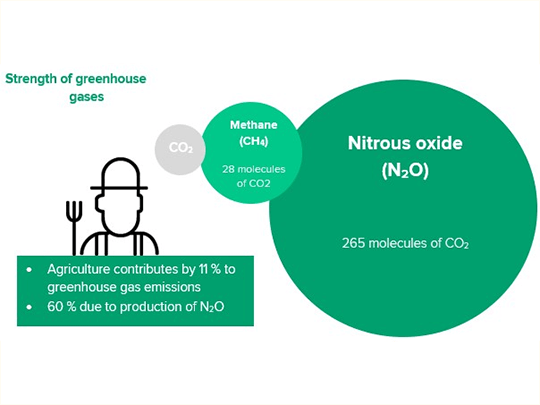Protein efficiency in ruminants – not just a topic for the cow’s performance
Reduce eutrophication. Over-fertilization of the fields. High nitrate pollution of the waters – Nitrogen losses are a big issue. These burden not only the environment, but also the revenue of the farmer. High protein efficiency is needed to prevent inefficient nitrogen (N) use – especially for milk production. But how can improved protein efficiency be achieved?
Do you know the crucial difference in protein metabolism between cattle and pigs?
In monogastric species like swine, essential amino acids are necessary to synthesize body protein. In ruminants there are two sites of digestion:
- in the rumen there are two important prerequisites for a high protein synthesis: energy in form of fermentable organic matter and sufficient degradable nitrogen supply
- in the small intestine the amino acids balance is important for bypass protein
What are the factors, determining protein efficiency in ruminants?
It’s all about the balance. Protein losses are linked with the balance between protein requirement and the protein level in the diet – an excess of protein cannot be utilized and is excreted. However, if the milk yield increases, more protein is needed for milk production and less is excreted unused.
An additional factor is the balance of amino acids of the diet related to the amino acids balance in the milk. It’s like Liebig’s famous barrel: Limiting factors, such as an insufficient amount of amino acids or low amounts of fermentable organic matter (FOM) in the rumen, reduce the milk yield. Thus, the amount of unused and excreted protein increases.
To understand how to improve the N-utilization and thus protein efficiency in ruminants, we should take a look at the N-metabolism in the rumen:Broadly speaking, ingested feed protein as well as non-protein nitrogen compounds (e.g. urea from saliva) are degraded by ruminal microorganisms to ammonia. With the help of energy from carbohydrate-rich food, a part of this ammonia is used to build up microbial protein. This microbial protein has a high biological value and can be used for growth and milk production, when it flushes from rumen to duodenum. However, not all protein is converted into microbial mass. The rest of the released ammonia in the rumen is converted to urea, as ammonia is a toxic metabolite which destroys cells. Thus, a large majority (70-75%) of ingested protein is excreted as urea through urine and as undigestible protein in the feces.

Hereby we can distinguish four different “parts” of inefficient N-losses:
Of course, there are some variables, determining the amount of inefficient N- losses.
That means:
- In the rumen, the excess of ammonia is linked to the protein degradation rate of feedstuffs, the ruminal passage rate (in relation to feed intake), condition inside the rumen (e.g. absence of acidosis), the amount of fermentable energy, the synchrony between energy and protein degradation and the availability of specific nutrients (like fat, sulfur or cobalt).
- In the small intestine, the losses are linked to the digestibility of the bypass protein (e.g. cotton seed meal vs. fish meal)
Why is protein efficiency in ruminants important to the environment?

Each year, 15 kg of ammonia is emitted per cow-place, which equates to three large buckets full of water. Ammonia is not only noticeable because of its unpleasant odor. Above all, the effects on the environment are the main problem. Especially big farms produce a huge amount of manure, which is mainly used as fertilizer.
The bacterial enzyme urease hydrolyses the urea, excreted with urine, into ammonia and CO2. Used as fertilizer, the ammonia gets into the environment and contributes to nitrate solution, as the ammonia is transformed by nitrifying soil bacteria into nitrite (NO2-) and nitrate (NO3-). Denitrifying soil bacteria transform this bioavailable nitrogen compounds into nitrous oxide (N2O), which escapes into the atmosphere.
Nitrate solution becomes a problem, especially in areas with high agricultural activity:
West of France, Northern Germany, the Netherlands, South of Ireland. And the list is getting longer. In the listed countries, nitrate levels up to 50mg/l groundwater can be detected. This drastically contributes to the eutrophication of lakes and dams: the nutrient imbalance in the water (excess of nitrates and phosphorus) increases the growth of algae and aquatic plants. When these plants die, bacteria consume large amounts of oxygen during decomposition processes. The loss of oxygen in the water contributes to fish mortality. This means negative consequences for the ecosystem balance. Not only the groundwater suffers from increased ammonia inputs: nitrous oxide (N2O) is one of the major greenhouse gases in addition to methane (CH4) and carbon dioxide (CO2). An increase in greenhouse gas emissions to the atmosphere leads to global warming.

Did you know?
Since both N2O and CH4 have high oxidation numbers, they are more involved in the greenhouse effect than CO2.
How do PFAs help to increase protein efficiency in ruminants and protect the environment?
It is important to consider, that the diet management like a balanced protein: energy ratio, an adequate supply of amino acids as well as high roughage quality contribute to an increased protein efficiency in ruminants. In addition, pure, plant-based phytogenic additives can help to reduce protein losses:

Specific condensed tannins have the ability to bind proteins in the rumen and release them into abomasum. Thus, the level of bypass protein is increased and there is a lesser amount of ruminal ammonia.

Triterpenoid saponins are able to reduce the protein hydrolyzation in the rumen and reduce the production of ammonia. Thus, losses of NH3 in the manure are reduced.

Essential oils improve microbial protein efficiency due to their defaunation activities.Moreover, they improve the amount of fermentable organic matter and enhance secretion of digestive juices.

Spices improve digestive enzyme production in the small intestine and thus support protein, starch and fat digestibility. That means there is a reduced protein amount in the feces.
As you can see, adding PFAs in the diet of dairy cattle means reduced protein losses in the urine and feces. Thus, the ingested feed protein can mainly be used for milk production, maintenance and growing. With the help of phytogenic feed additives, it is possible to improve the protein efficiency in dairy cows (more milk protein produced per kg of protein in the diet) – as consequence there are lesser residues in the environment.
References available upon request

Thierry Aubert
Thierry Aubert can look back on 15 years of experience in the premix, feed and meat industry. Since the beginning of his career, Thierry is in regular exchange with the farmers to understand their challenges and needs. In 2013 he joined Delacon as Species Leader Ruminants. With his team, he is in charge of the global product development for the ruminant species and customer technical support. Since spring 2018, his task areas have been extended: At the moment, he is also responsible for the coordination of the Reginal Technical Managers worldwide. In his leisure time, he likes to go running and already participated in several marathons.

Anne Oberdorf
Anne has always been fascinated by the unknown, the diversity and beauty of nature. Her love for nature brought her to Delacon in 2018 after studying agricultural sciences, where she worked as Technical Communications Manager and later as Product Manager Aquaculture. Since February 2021, she has been taking a new, natural career path outside of Delacon.










